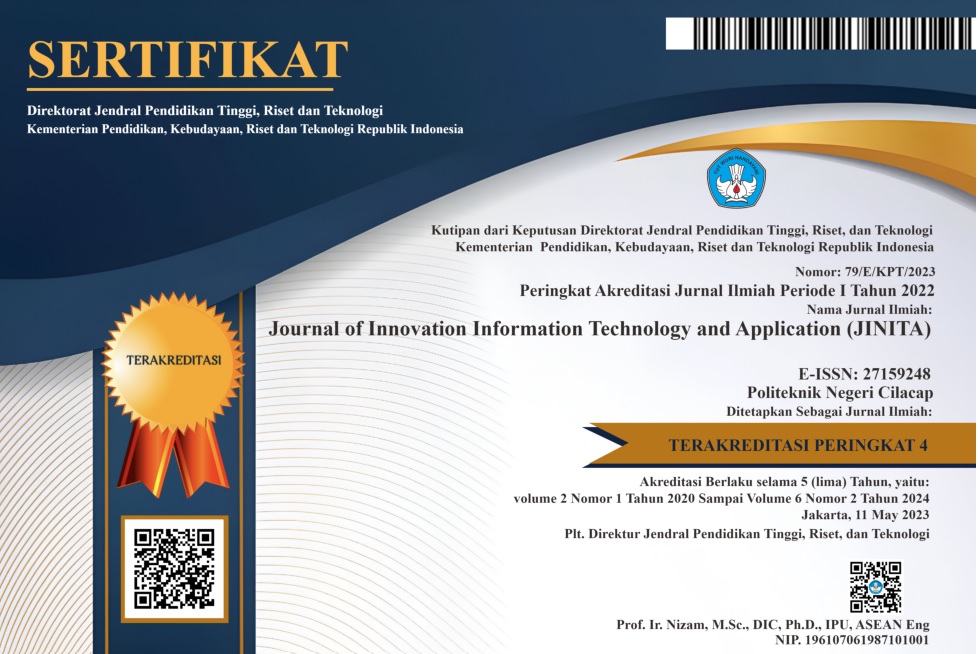Implementasi K-Means Clustering Pada Sistem Pakar Penentuan Jenis Sayuran
 Abstract views: 486
,
Abstract views: 486
,
 PDF downloads: 582
PDF downloads: 582
Abstract
Indramayu is one of the regencies in West Java Province that produces food crop production in the agricultural and plantation sectors. Many people work in the agricultural sector, one of which is by growing vegetables on their land. Planting vegetables on land in the Indramayu area often experiences problems, for example the land used is not in accordance with the type of vegetables grown. Some farmers have difficulty in evaluating land due to their lack of understanding of the land to be planted so that farmers rely on the system of planting habits that they usually do. The wrong land selection can result in energy and financial losses used for maintenance. Vegetables will develop imperfectly, even vegetables can die because of the inappropriateness of the land used. This study aims to assist farmers in determining what types of vegetable crops can be planted on their land using the k-means clustering method. There are 7 data criteria used for processing k-means so that later it can produce output a recommendation of vegetable types that can be planted by farmers according to the criteria they enter into the system. The results of this study produce an expert system that can provide information about vegetables selected according to the criteria selected by each user and with this system, ordinary people can find out how the selection of types of vegetables is practically on the land to be planted with vegetables.
References
Y. Lasena and Y. Malago, “Clustering Komoditi Unggulan Daerah Provinsi Gorontalo Menggunakan Algoritma K-Means,” Jambura J. Electr. Electron. Eng., vol. 2, no. 1, pp. 14–18, 2020.
N. Erlangga, S. Solikhun, and I. Irawan, “Penerapan Data Mining Dalam Mengelompokan Produksi Jagung Menurut Provinsi Menggunakan Algoritma K-Means,” KOMIK (Konferensi Nas. Teknol. Inf. dan Komputer), vol. 3, no. 1, pp. 702–709, 2019.
T. Tendean and W. Purba, “Analisis Cluster Provinsi Indonesia Berdasarkan Produksi Bahan Pangan Menggunakan Algoritma K-Means,” J. Sains dan Teknol., vol. 1, no. 2, pp. 5–11, 2020.
C. Armayani, A. Fauzi, and H. Sembiring, “Implementasi Data Mining Pengelompokan Jumlah Data Produktivitas Ubinan Tanaman Pangan Berdasarkan Jenis Ubinan Dengan Metode Clustering Dikab Langkat,” J. Inform. Kaputama, vol. 5, no. 1, pp. 185–196, 2021.
B. Ichsan, B. H. Wibowo, and M. N. Sidiq, “Penyuluhan Pentingnya Sayuran Bagi Anak Anal di TK Aisyiyah Kwadungan,” J. War., vol. 18, no. 1, pp. 29–35, 2015.
F. Arbie, “Pengetahuan Gizi Berhubungan dengan Konsumsi DSayur dan Buah pada Remaja,” Heal. Nutr. J., vol. I, pp. 23–31, 2015.
D. Septiadi and M. Nursan, “Optimasi Produksi Usaha Tani Sebagai Upaya Peningkatan Pendapatan,” J. Agrifo, vol. 5, no. 2, pp. 87–96, 2020.
H. A. Negara, A. R. Putra, and U. Enri, “Clustering Clustering Data Eskspor Buah-Buahan Berdasarkan Negera Tujuan Menggunakan Algoritma K-Means,” Bina Insa. Ict J., vol. 8, no. 1, p. 73, 2021.
E. Humaidi, B. Unteawati, and A. Analianasari, “Pemetaan Komoditas Sayur Unggulan Di Provinsi Lampung,” J. Agribisnis Indones., vol. 8, no. 2, pp. 106–114, 2020.
R. D. P. Setiawan, “Penerapan Metode K-Means Clustering Untuk Analisis Potensi Produksi Komoditi Buah Pada Kabupaten Lumajang,” JATI (Jurnal Mhs. Tek. Inform., vol. 2, no. 2, pp. 263–269, 2018.
H. Gustia, Rosdiana, and Junaidi, “Budidaya Tanaman Sayuran pada Lahan Pekarangan dengan Teknik Vertikultur dan Hidroponik,” Pros. Semin. Nas. Pengabdi. Masy. LPPM UMJ, vol. 1, no. September 2019, pp. 1–6, 2019.
J. Jamalludin, “Analisis Faktor-Faktor Yang Mempengaruhi Produksi Usahatani Sayur-Sayuran Di Kelurahan Maharatu Kecamatan Marpoyan Damai Kota Pekanbaru,” J. Agribisnis, vol. 20, no. 1, pp. 52–67, 2018.
M. Septiana and Z. T. Mariana, “Kajian kesesuaian lahan untuk tanaman hortikultura di Desa Ampukung, Kecamatan Kelua, Kabupaten Tabalong, Provinsi Kalimantan Selatan,” Pros. Semin. Nas. …, vol. 3, no. April, pp. 384–387, 2018.
Sani Askia, Nurul Hidayat, and Ratih Kartika Dewi, “Kelompok Penyakit Tanaman Apel Menggunakan Metode K-Means Berbasis Web,” Pengemb. Teknol. Inf. dan Ilmu Komput., vol. 2, No.8, no. e-ISSN: 2548-964X, pp. 2435–2441, 2018.
S. Raharjo, W. Widiatmaka, and U. Sudadi, “Land Suitability Analysis for Primary Vegetable Commodities in Batang Regency,” J. Nat. Resour. Environ. Manag., vol. 5, no. 1, pp. 33–41, 2015.
S. Mauluddin and N. Suarna, “Sistem Pakar Penentuan Jenis Tanah Berdasarkan Kadar PH Untuk Tanaman Palawija Menggunakan Metode K-Means Clustering,” J. ICT Inf. Commun. Technol., vol. 17, no. 1, pp. 11–15, 2018.
D. N. Utama, “Fuzzy Decision Support Model for Determining Plants Planted in Specific Suitable Areas in Indonesia,” Int. J. Emerg. Trends Eng. Res., vol. 8, no. 5, pp. 1517–1522, 2020.
M. S. Rosa A.S, Rekayasa Perangkat Lunak. Informatika Bandung, 2018.
Copyright (c) 2022 Journal of Innovation Information Technology and Application (JINITA)

This work is licensed under a Creative Commons Attribution 4.0 International License.
Authors who publish with this journal agree to the following terms:
- Authors retain copyright and grant the journal right of first publication with the work simultaneously licensed under a Creative Commons Attribution License that allows others to share the work with an acknowledgement of the work's authorship and initial publication in this journal.
- Authors are able to enter into separate, additional contractual arrangements for the non-exclusive distribution of the journal's published version of the work (e.g., post it to an institutional repository or publish it in a book), with an acknowledgement of its initial publication in this journal.
- Authors are permitted and encouraged to post their work online (e.g., in institutional repositories or on their website) prior to and during the submission process, as it can lead to productive exchanges, as well as earlier and greater citation of published work (See The Effect of Open Access).
















